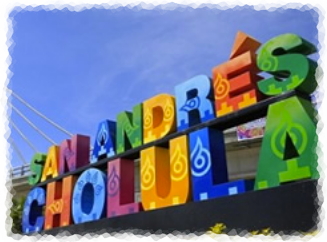
| When Offered: Flexible days but you need to book in advance
Cost: Depending on the number of people on the tour.
Included: Guide and transport
| We will visit the Cholula Archeaological zone, the largest Mesoamerican pyramid, examine the tunnels, parts of which we will walk through. We will also take a look at the Courtyard of the altars. We will comment on that particular building, its murales like Los Chapulines (the grasshoppers) and Los Bededores (the drinkers) and discuss the possible uses of the building. We will see some polichrome pottery.
After that, we will head to Santa Maria Tonanzintla, San Francisco Atepec, in order to visit the ostentatious Cathedral and the town square (zócalo) while discussing the most important historical events associated with the city of Puebla.
|
|
| Schedule: we will go to the Franciscan temple with its enormous atrium and beautiful Franciscan library. Following that we will visit the main plaza with its pretty arcade, then tour the archaeolgical zone and visit its tunnels and the patio of the altars on the southern face of Tlachihualtepetl as well. We will see the west side of the pyramid that has been reconstructed to give us an idea of what its staircases and surfaces looked like.
|
This tour is important for understanding the Mesocamerican Postclassic period. The fall of Tollan (Teotihuacan) has been converted into a key element of the origin legends of the kingdoms of the south and center of México. The presence of Quetzalcóatl as a devotional figure, particularly in the city of Cholula in the modern satae of Puebla, suggests that Cholula became the new Tollan. This new Tollan was important in Mesoamerica as the center of trade and pilgrimages and was the source of religious and political cohesion.
After the conquest, the arrival of the second wave of immigrants, charged with reversing the excesses of the first court, considered that had to do something in order to protect the properties of the natives. The new population was situating itself between Veracruz and Mexico City and between Tlaxcala and Cholula. This completely new population wave, since the plots of land were not to be given to the conquerors, would bring with it field workers and farmers who would make a living off the land and not off the natives. Because of this new approach, the city of Cholula was founded in 1531 as a social utopian experiment aimed at combating the aristocratic tendencies that were coming into play.
|
 |
 |